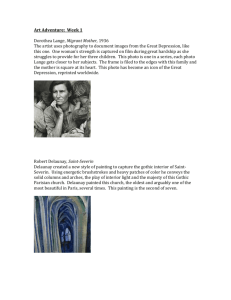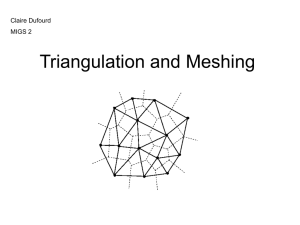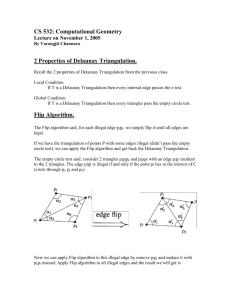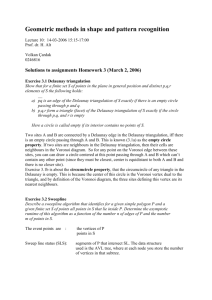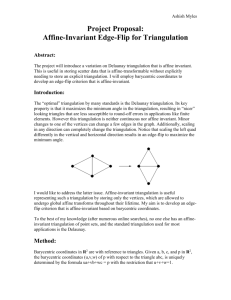Near-Linear-Time Deterministic Plane Steiner Spanners for Well-Spaced Point Sets Glencora Borradaile
advertisement
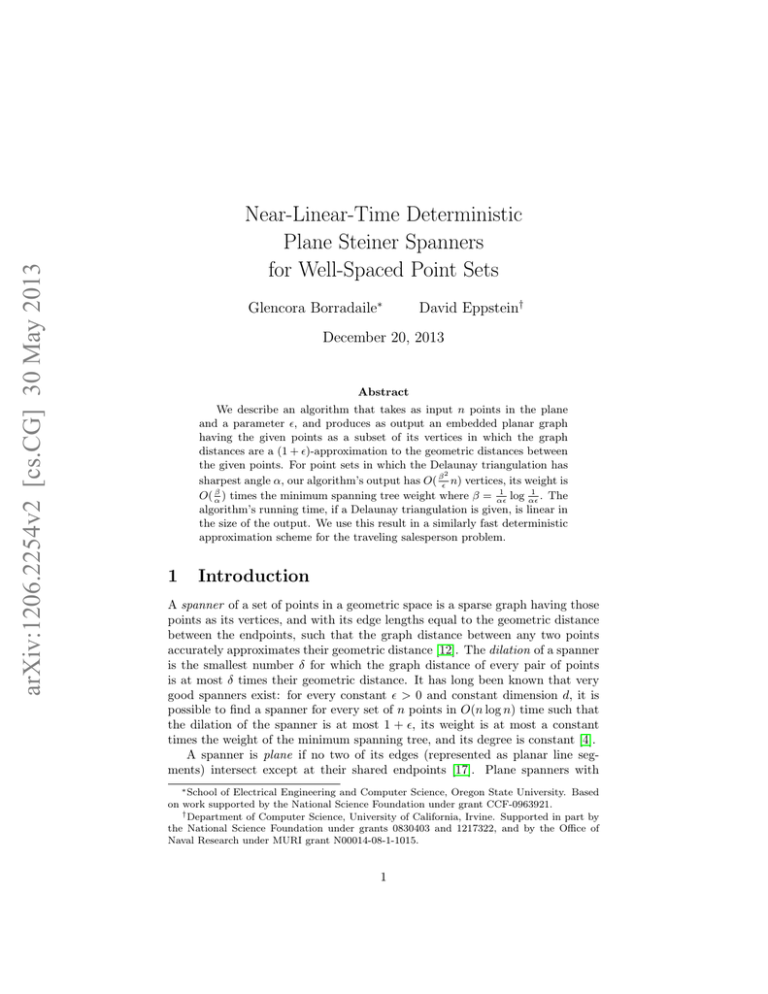
arXiv:1206.2254v2 [cs.CG] 30 May 2013
Near-Linear-Time Deterministic
Plane Steiner Spanners
for Well-Spaced Point Sets
Glencora Borradaile∗
David Eppstein†
December 20, 2013
Abstract
We describe an algorithm that takes as input n points in the plane
and a parameter , and produces as output an embedded planar graph
having the given points as a subset of its vertices in which the graph
distances are a (1 + )-approximation to the geometric distances between
the given points. For point sets in which the Delaunay triangulation has
2
sharpest angle α, our algorithm’s output has O( β n) vertices, its weight is
β
1
1
O( α
) times the minimum spanning tree weight where β = α
log α
. The
algorithm’s running time, if a Delaunay triangulation is given, is linear in
the size of the output. We use this result in a similarly fast deterministic
approximation scheme for the traveling salesperson problem.
1
Introduction
A spanner of a set of points in a geometric space is a sparse graph having those
points as its vertices, and with its edge lengths equal to the geometric distance
between the endpoints, such that the graph distance between any two points
accurately approximates their geometric distance [12]. The dilation of a spanner
is the smallest number δ for which the graph distance of every pair of points
is at most δ times their geometric distance. It has long been known that very
good spanners exist: for every constant > 0 and constant dimension d, it is
possible to find a spanner for every set of n points in O(n log n) time such that
the dilation of the spanner is at most 1 + , its weight is at most a constant
times the weight of the minimum spanning tree, and its degree is constant [4].
A spanner is plane if no two of its edges (represented as planar line segments) intersect except at their shared endpoints [17]. Plane spanners with
∗ School
of Electrical Engineering and Computer Science, Oregon State University. Based
on work supported by the National Science Foundation under grant CCF-0963921.
† Department of Computer Science, University of California, Irvine. Supported in part by
the National Science Foundation under grants 0830403 and 1217322, and by the Office of
Naval Research under MURI grant N00014-08-1-1015.
1
bounded dilation are known; for instance, the Delaunay triangulation is such
a spanner [9]. However, it is not possible for these spanners to have dilation
arbitrarily close to one. For instance, for four points at the corners of a square,
√
any plane graph must avoid one of the diagonals and have dilation at least 2.
However, the addition of Steiner points allows smaller dilation for pairs of original points. For instance, the plane graph formed by overlaying all possible line
segments between pairs of input points has dilation exactly one, although its
Θ(n4 ) combinatorial complexity is high. Less trivially, in the pinwheel tiling, a
certain aperiodic tiling of the plane, any two vertices of the tiling at geometric
distance D from each other have graph distance D + o(D) [18]. We define a
plane Steiner δ-spanner for a set of points to be a graph that contains the points
as a subset of its vertices, is embedded with straight line edges and no crossings
in the plane, and achieves dilation δ for pairs of points in the original point set.
We do not require pairs of points that are not both original to be connected by
short paths.
Arikati et al. [2] show how to construct a plane Steiner spanner in O(n log n)
time, but do not bound the total weight of the graph. Of course, spanners may
also be constructed by forming an arrangement of line segments [11] representing
the edges of a nonplanar spanner graph; this planarization does not change the
spanner’s weight, but may add a large number of edges and vertices. A paper
of Klein [14] on graph spanners provides an alternative basis for plane Steiner
spanner construction. Generalizing a previous result of Althöfer et al. [1], Klein
shows that any n-vertex planar graph with a specified subset of vertices may
be thinned to provide a planar Steiner (1 + )-spanner for the graph distances
on the specified subset, with weight O(1/4 ) times the weight of the minimum
Steiner tree of the subset, in time O((n log n)/). Klein combined this result with
methods from another paper [15] to provide a polynomial time approximation
scheme for the traveling salesperson problem in weighted planar graphs. Using
Klein’s method to reduce the weight of the geometric spanner formed by the
arrangement of all line segments connecting pairs of a given point set would lead
to a low weight plane (1 + ) Steiner spanner for the point set, but again with
a large number of vertices and edges. Ideally, we would prefer plane Steiner
spanners that not only have low weight, but also have a linear number of edges
and vertices.
Small and low-weight plane Steiner spanners in turn could be used with
Klein’s planar graph algorithms to derive a deterministic polynomial time approximation scheme for the Euclidean TSP. The previous randomly shifted
quadtree approximation scheme of Arora [3] and guillotine subdivision approximation scheme of Mitchell [16] have runtimes that are polynomial for fixed but with an exponent depending on ; in contrast, Klein’s method takes time
linear in the spanner size for any fixed . However, combining Klein’s method
with the nonlinear-size Steiner spanners described above would not improve on
a different deterministic TSP approximation scheme announced by Rao and
Smith [19]. Their method is based on banyans, a generalized type of spanner
that must accurately approximate all Steiner trees, and it takes O(n log n) time
for any fixed and any fixed dimension, although its details do not appear to
2
have been published yet.
These past results raise several questions. Are banyans necessary for fast
TSP approximation, or is it possible to make do with more vanilla forms of
spanners? How quickly may low-weight plane Steiner spanners be constructed,
and how quickly may the TSP be approximated? And how few vertices are
necessary in a plane Steiner spanner?
In this work we provide some partial answers, for planar point sets that
are well-spaced in the sense that their Delaunay triangulation avoids angles
sharper than α for some α. We show that, when both and α are bounded by
2
fixed constants, there exist plane Steiner (1 + )-spanners with O( β n) vertices
β
whose weight is O( α
) times the minimum spanning tree weight where β =
1
1
log
.
Note
that
the
weight depends linearly on 1 , improving the quartic
α
α
dependence given by Klein’s thinning procedure, which additionally has O(n4 )
vertices. Our spanners may be constructed in linear time given the Delaunay
triangulation. In order to use our spanner for approximating Euclidean TSP,
we may assume that our points have integer coordinates and so we can use
the fast Delaunay triangulation algorithm of Buchin and Mulzer [10]
√ with fast
integer sorting algorithms [13]) to find the triangulation in time O(n log log n).
Combining our spanners with the methods from Klein [15] leads to near-lineartime TSP approximation for the same class of point sets.
2
Delaunay triangulations without sharp angles
The Delaunay triangulation DT of a set S of points (called sites) is a triangulation in which the circumcircle of each triangle does not contain any sites
in its interior. For points in general position (no four cocircular) the Delaunay
triangulation is uniquely defined and its sharpest angle α is at least as large
as the sharpest angle in any other triangulation. As we show in this section,
Delaunay triangulations that do not have any triangles with sharp angles have
two key properties:
1. Their total weight w(DT) is small relative to the weight w(MST) of the
minimum spanning tree.
2. Every point in the plane is covered by only a few circumcircles.
We use the first property to bound the total weight of the final spanner as each
edge we add will have length at most that of the Delaunay triangle in which it
is embedded. In order to approximate a the length of a line, we will charge the
error incurred to a chord given by the intersection of the line with the interior
of a Delaunay circumcircle. Since a part of the line may be enclosed by multiple
circumcircles, the error we charge will multiply by this factor. By bounding this
factor, using the second property, we bound the total error.
Lemma 1.
w(DT) ≤ fw (α)w(MST) where fw (α) =
3
1 + cos α
.
1 − cos α
e4
e3
e1
e2
Figure 1: An ordering for the edges in the proof of Lemma 1. The MST is given
by the solid edges. The non-MST edges are dashed and, viewed in the dual of
the plane graph defined by the DT, form a spanning tree of this dual graph.
Proof. The proof follows closely to that of Lemma 3.1 of Klein [14]. Let T be
the MST. (Recall T ⊆ DT.) Consider the dual graph of the plane graph defined
by DT and refer to Figure 1. The edges DT \ T , viewed in the dual, form a
spanning tree T ∗ of the dual graph. Rooting T ∗ at the vertex corresponding to
the outside of the DT, we consider any leaf-to-root order of DT \ T with respect
to T ∗ . Let e1 , e2 , . . . , ek be that ordering.
Let H0 be the non-self-crossing Euler tour of T . The first non-MST edge,
e1 , makes a triangle with edges a1 and b1 of H0 . Recursively define Hi as the
tour resulting from removing ai and bi from Hi−1 and adding ei :
w(Hi ) = w(Hi−1 ) + w(ei ) − w(ai ) − w(bi )
Since the α is the smallest angle of triangle ei ai bi and ei is longest when
w(ai ) = w(bi ), we get
w(ei ) ≤ (w(ai ) + w(bi )) cos α.
Combining, we get:
w(Hi ) ≤ w(Hi−1 ) + (1 − 1/ cos α) w(ei ).
Summing:
w(Hk ) ≤ w(H0 ) + (1 − 1/ cos α)
X
w(ei ).
i
Rearranging gives:
X
i
w(ei ) ≤
2 cos α
w(H0 ) − w(Hk )
≤
w(MST)
1
1 − cos α
cos α − 1
where the last inequality follows
from w(Hk ) ≥ 0 and w(H0 ) = 2 w(MST).
P
Since w(DT ) = w(MST) + i w(ei ), we get the lemma.
4
Lemma 2. The number of Delaunay circumdisks whose interiors contain a
given point in the plane is at most
fe (α) = 2π/α.
(1)
Proof. The lemma trivially holds for points that are sites. Let x be a non-site
point in the plane. Then the Delaunay triangles whose circumcircles contain
x are exactly the ones that get removed from the Delaunay triangulation if we
add x to S and re-triangulate. Therefore, the number of Delaunay circumcircles
that contain x is the same as the degree of x in the Delaunay triangulation,
DTx of S ∪ {x}.
Let d be the degree of x in DTx . Then, one of the triangles, xqr, in DTx
incident to x has an angle at x of at most 2π/d. Edge qr must be a side of a
triangle qrs in DT because, after the removal of x, line segment qr is still a chord
of the empty circle that circumscribed xqr. However since the circumcircle of
triangle qrs contains x, this circumcircle extends at least as far from the x-side
of qr as the circumcircle of xqr. Therefore angle qsr is at least as sharp as angle
qxr. So it must be that 2π/d ≥ α, proving the lemma.
q
x
s
r
Figure 2: An illustration of the construction in the proof of Lemma 2. DTx is
given by the dark edges and DT is given by the convex hull of DTx and the
gray edges. The circumcircles of triangles qrx and qrs are illustrated.
5
Y
F
A
B
X
D
C
E
Figure 3: Illustration of the statement and proof of Lemma 3
3
Portals for chords
As we now show, it is possible to space a set of portals along an edge of a
Delaunay triangulation in such a way that any chord of a Delaunay circumcircle
must pass close to one of the portals, relative to the chord length.
Lemma 3. Let AD be a chord of a circle O, let B and C be points interior to
segment AD, and let EF be another chord of O, crossing AD between B and
C. Then the distance from chord EF to the nearer of the two points B and C
is at most
|EF | · |BC|
.
2 min(|AB|, |CD|)
Proof. The points of the lemma are illustrated in Figure 3. We assume without
loss of generality that F is on the side of AD that contains the center of O,
as drawn in the figure; let Y be the point of O farthest from X, lying on the
line through X and the center of O. Note that the distance from line EF to
the closer of B and C is at most min(|BX|, |CX|) ≤ |BC|/2, so it remains to
prove that |EF | ≥ min(|AB|, |CD|). But if F lies on the arc between A and
Y , then |EF | ≥ |F X| ≥ |AB|, and if F lies on the arc between Y and D then
|EF | ≥ |F X| ≥ |CD|. In either case the result follows.
Lemma 4. Let s be a line segment in the plane, and let > 0. Then there
exists a set Ps, of O( 1 log 1 ) points on s with the property that, for every circle
O for which s is a chord, and for every chord t of O that crosses s, t passes
within distance |t| of a point in Ps, .
Proof. Our set Ps, includes both endpoints of s and its midpoint. Refer to
Figure 4. In the subset of s from one endpoint p0 to the midpoint m, we add a
sequence of points pi , where p1 is at distance O(2 s) from p0 with a constant of
proportionality to be determined later and where for each i > 1, pi is at distance
2 d(p0 , pi−1 ) from pi−1 . Because the distance from p0 increases by a (1 + )
factor at each step, the set formed in this way contains O( 1 log 1 ) points.
6
If chord t crosses s between some two points pi and pi+1 for i ≥ 1, or between
the last of these points and the midpoint of s, then by Lemma 3 the distance
from t to the nearer of these two points is at most:
2|t| · |p0 pi |
|t| · |pi pi+1 |
=
= |t|.
2|p0 pi |
2|p0 pi |
Otherwise, t crosses s between p0 and p1 . Let r be the radius of O, necessarily
at least |s|/2, and suppose that t passes within distance δr of p0 . Because of
the choice of p1 , δ = O(2 ). Applying
√ Theorem to the shaded
√ the Pythagorean
δ). Combining this with
triangle in Figure 4 we get |t| ≥ r 2δ − δ 2 = Ω(r √
the definition of δ shows that t is within distance O( δ|t|) = O(|t|) of p0 . By
choosing the constant of proportionality for the placement of p1 appropriately
we can ensure that this distance is at most |t|.
(1 −
p0
p1 p 2 p 3
δ )r
t/2
r
p4 m
Figure 4: The set of points Ps, along a chord s (horizontal line) of a circle O.
An illustration of the final case of the proof of Lemma 4.
We call the points in Ps, portals.
4
Spanning the portals within each triangle
Within each triangle of the Delaunay triangulation, we will use a plane Steiner
spanner that connects the portals that lie on the triangle edges. For this special
case, we use a construction that generalizes to an arbitrary set P of points on
the boundary of an arbitrary planar convex set K. Consider a line L and that
makes an angle θ with the vertical. For δ ∈ [0, π/2), we say that a path is
(θ ± δ)-angle-bounded if it is piecewise linear and the smallest angle between
each linear segment and L is at most δ. We say that a point p on the boundary
of K is (θ ± δ)-extreme if all rays starting at p and making an angle at most δ
with L are external to K.
7
Figure 5: An illustration of the construction for Lemma 6 with θ = 0.
Lemma 5. Every (θ ± δ)-angle-bounded path has length 1 + O(δ 2 ) times the
distance between its endpoints.
Proof. The most extreme case is a path that follows two sides of an isosceles
triangle having the endpoints of the path as base, for which the length is the
length of the base multiplied by 1/ cos δ = 1 + O(δ 2 ).
Lemma 6. Let P be a set of n points on the boundary of a convex set K with
perimeter `, let θ be an angle and let δ ∈ [0, π/2). Then in time O(n log n)
we can construct a set S of O(n) line segments within K, with total length
O((` log n)/δ), with the property that for every point p in P there exists a (θ±δ)angle-bounded path in S from p to a (θ ± δ)-extreme point of K.
Proof. We consider the points of P in an order we will later define; for each
such point p that is not itself (θ ± δ)-extreme, we extend two line segments with
angles θ − δ and θ + δ until reaching either an extreme point of K or one of the
previously constructed line segments. Thus, a (θ ± δ)-angle-bounded path from
p may be found by following either of these two line segments, and continuing
to follow each line segment hit in turn by the previous line segment on the path,
until reaching an extreme point.
The non-extreme points of P , because K is convex, form a contiguous sequence along the boundary of K. We extend segments from the two endpoints of
this sequence, then from its median, and then finally we continue recursively in
the two subsequences to the left and right of the median, as shown in Figure 5.
The segments from the first two points of P contribute a total length at
most ` to S. Consider the ray s extended at an angle of, w.l.o.g., θ + δ from p.
Let t be the ray extended at an angle of θ − δ from the most recently considered
point p0 counter-clockwise along the boundary of K from p. Consider the right
triangle one of whose corners c is the intersection of t and s, another of whose
corners is p and makes an angle δ at c. (This triangle is shaded in Figure 6.)
Let r be the right angle in this triangle. Then |pc| = |pr|/ sin δ = O(|pr|/δ).
Since a subsection of pc is added to S and the (shorter) boundary of K from p
to p0 is at least as long as pr, the length of each added segment for point p is at
8
most proportional to 1/δ times the length of the part of the boundary of K that
extends from p to the most recently previously considered point in the same
direction. Because of the ordering of the points, each point along the boundary
is charged in this way for O(log n) segments, so adding this quantity over all
points, the total length of the segments is O((` log n)/δ) as claimed. We may
construct S in O(n log n) time by using binary search to determine the endpoint
on K of each segment.
c
δ
p0
r
p
Figure 6: An illustration for proof of Lemma 6.
Lemma 7. Let P be a set of n points on the boundary of a convex set K with
perimeter `, and let > 0 be a positive number. Then in time O(n2 /) we can
construct a plane Steiner (1 + )-spanner for P , with all spanner edges in K,
with O(n2 /) edges and vertices, and with total length O((` log n)/).
√
Proof. We choose δ = O( ) (with a constant of proportionality determined
later). Consider the O(1/δ) angles, θ0 , θ1 , . . ., in [0, 2π) that are multiples of 2δ.
We apply Lemma 6 for each angle θi with δ as defined. We overlay the resulting system of O(n/δ) line segments; when two line segments from different arcs
both have the same angle and starting point, we choose the longer of the two
to use in the overlay. The resulting arrangement of line segments has O(n2 /)
edges and vertices and total length O((` log n)/) as required, and can be constructed in time O(n2 /) using standard line segment arrangement construction
algorithms [11].
To see that this is a spanner, we must show that every pair (p, q) of points in
P may be connected by a short path. Let θ be the angle formed by the segment
from p to q, choose i such that θ + δ ≤ θi ≤ θ + 3δ, and use Lemma 6 to find
a (θi ± δ)-angle-bounded path pp0 in the spanner from p to a (θi ± δ)-extreme
point p0 . Because of the angle bound, p0 must be clockwise of q. Similarly,
we may choose θj within O(δ) of π + θ, and find a (θj ± δ)-angle-bounded
path qq 0 to a (θj ± δ)-extreme point q 0 that is counterclockwise of p. These
9
q
p´
q´
p
Figure 7: Illustration of the proof of Lemma 7
two paths (depicted in Figure 7) must cross at at least one point x, and the
combination of the path from p to x and from x to q lies within the spanner
and is (θ ± O(δ))-angle-bounded. By Lemma 5, this path has length at most
1+O(δ 2 ) times the distance between its endpoints, and by choosing the constant
of proportionality in the definition of δ appropriately we can cause this factor
to be at most 1 + .
5
Spanner construction
We now have all the pieces for our overall spanner construction.
Theorem 1. Let P be a planar point set whose Delaunay triangulation is given
and has sharpest angle α, and let > 0 be given. Then in time O(n log2 (1/(α))/(α2 3 ))
we can construct a plane Steiner (1+)-spanner for P with O(n log2 (1/(α))/(α2 3 ))
vertices and edges, and with total length O(w(MST) log(1/(α))/(α2 )).
Proof. We apply Lemma 4 to place portals along the edges of the triangulation,
such that each chord s of a Delaunay circle passes within distance O(α|s|) of a
portal on each Delaunay edge that it crosses. We then apply Lemma 7 within
each Delaunay triangle to construct a 1 + O()-spanner for the portals on the
boundary of that triangle.
The construction time is bounded by the time to construct the spanners
within each triangle. Since there are O(log(1/(α))/(α)) portals on each triangle, the time to construct the spanner for a single triangle is O(log2 (1/(α))/(α2 3 ))
and the total time over the whole graph is O(n log2 (1/(α))/(α2 3 )). This bound
also applies to the number of vertices and edges in the constructed spanner. By
Lemma 1, the total perimeter of the Delaunay triangles is O(w(MST)/α2 ), and
combining this bound with the length bound of Lemma 7 gives total length
O(w(MST) log(1/(α))/(α2 )) for the spanner edges.
To show that this is a spanner, we must find a short path between any
two of the input points p and q. By Lemma 3, the line segment pq passes
10
within distance O(α|s|) of a portal on every Delaunay edge that it crosses,
where s is the chord of one of the Delaunay circles for the crossed edge. By
Lemma 2, the total length of all of these chords is O(|pq|/α), so we may replace
pq by a polygonal path that contains a portal on each crossed Delaunay edge,
expanding the total length by a factor of at most 1 + O((α)/α) = 1 + O().
Then, by Lemma 7 we may replace each portal-to-portal segment in this path
by a path within the spanner for the portals in a single Delaunay triangle, again
expanding the total length by a factor of at most 1+O(). By choosing constants
of proportionality appropriately, we may make the total length expansion be at
most 1 + .
6
Approximating the TSP
An algorithm of Klein [15] provides a linear time approximation scheme for the
traveling salesperson problem in a planar graph. Its first step is to find a lowweight spanner of the graph. A subsequent paper, also by Klein [14] describes
an algorithm that, given a planar graph G and a subset S of the nodes, finds a
subgraph of G whose weight is O(−4 ) times that of the minimum-weight tree
spanning S and that is a (1 + )-spanner for the shortest-path metric on S [14].
This subset spanner construction can be substituted for the first step of Klein’s
approximation scheme, resulting in an algorithm for approximating the TSP
on the subset S. However, in this more general result, the spanner construction takes time O(n log n), so the total time for the approximation scheme is
O(n log n) for any fixed > 0.
The first step for approximating Euclidean TSP is to round the coordinates
of the sites to their nearest integer coordinates
on a sufficiently fine grid. Doing
√
so allows us to take advantage of O(n log log n) Delaunay triangulation [10]
made possible by fast integer sorting [13]. We may then substitute our own
faster low-weight spanner construction for the first step of the approximation
scheme. The remaining steps of the approximation use only the facts that the
points we are seeking to connect into a tour are vertices in a planar graph, and
that the whole graph has total weight proportional to the minimum spanning
tree of the given points. Thus, we obtain the following result:
Corollary 1. For any fixed α and , we may find a (1 + )-approximation to
the optimal traveling salesman tour of sets of n points in the plane with sharpest
Delaunay triangulation angle at most α in time O(n) plus the time needed to
construct the Delaunay triangulation.
It would also be possible to design a TSP approximation scheme more directly using a framework used by Borradaile, Klein and Mathieu [8] to solve the
Steiner tree problem; details on how this framework applies to TSP were given
by Borradaile, Demaine and Tazari [7] in generalizing the planar framework to
bounded-genus graphs. Their algorithm, as interpreted for point sets in the Euclidean plane, would partition the triangles of the Delaunay triangulation into
layers according to their depth from the infinite face in the dual graph so that the
11
sum of the lengths of line segments common to different layers is an fraction
of
the optimal solution. This can be achieved with depth fw (α)/ = O α12 ; each
layer has tree-width polynomial in this depth. The problem is then solved using
dynamic programming, where the dynamic programs are additionally indexed
by the portals. The base cases are made to correspond to the triangles in which
the intersection with any tour can be enumerated. The size of the dynamic
program is therefore bounded singly-exponentially in 1/ and 1/α. This task
is slightly easier in the geometric setting than in the planar graph setting as
computing shortest paths is trivial.
7
Looking ahead
The most obvious question posed by this work is: how do we remove the dependence on α? The dependence on α appears in two places: in the number
of circumcircles that enclose a point and in the weight of the Delaunay triangulation. The former affects the error incurred by using portals and the latter
affects the weight of the final spanner. We believe that it should be possible
to remove these dependencies on α by treating groups of skinny triangles as a
single region. In fact, using this idea, we are able to remove each dependency
separately, but not together. By removing a long edge connecting two skinny
triangles, we reduce the number of portals we must reroute through, but the
number of skinny triangles that define a given region could be many, and adding
the edges to build the spanner within this region will depend on this number.
On the other hand, we could only consider regions defined by a small number
of triangles, but this may not be enough to reduce the number of circumcircles
a chord is within.
An alternative approach to removing this dependence would be to augment
the input to remove all sharp angles from its Delaunay triangulation, but this
may sometimes need a number of added points that cannot be bounded by a
function of n [5]. A construction based on quadtrees shows that every point set
may be augmented with O(n) points so that the Delaunay triangulation has no
obtuse angles [5]; the resulting triangulation may also be modified to have the
bounded circumcircle enclosure property, despite having some sharp angles, and
may be constructed as efficiently as sorting [6]. Applying our spanner construction method to the augmented input would allow us to completely eliminate the
dependence on α in the time and output complexity of our spanners, but at the
expense of losing control over their total weight. Once a spanner is constructed
in this way, Klein’s subset spanner [14] can be used to reduce its weight, allowing it to be used in an algorithm to approximate the TSP for arbitrary planar
point sets in time O(n log n) for any fixed > 0, but this does not improve on
the time bound of Rao and Smith [19].
Unlike in the methods of Arora [3], Mitchell [16], Rao and Smith [19] and
Borradaile, Klein and Mathieu [8], the approximation error in our method is
charged locally as opposed to globally. In the quad-tree based approximation
schemes, the error incurred is charged to the dissection lines that form the quad
12
tree. In the planar approximation-scheme framework for Steiner tree, the error
incurred is charged to an O(MST)-weight subgraph called the mortar graph
which acts much like the quad-tree decomposition. Our charging scheme is
much more similar to that used by Klein for the subset tour problem in planar
graphs [14]. However, in applying the planar approximation-scheme frameworks
of either Klein or Borradaile, Klein and Mathieu, some error is incurred in partitioning the graph into pieces of bounded treewidth. This error is proportional
to the graph that is partitioned, which in our case is either the spanner (for
Klein’s scheme) or the triangulations (for Borradaile et. al’s scheme). This error is indirectly related to OPT by way of the O(MST) weight of the spanner
and triangulation. By current techniques, this source of error does not seem
avoidable.
Finally, our spanner construction more closely ties Euclidean and planar
distance metrics together. By unifying the approximation schemes in these two
related metrics, it may be possible to generalize these methods to other twodimensional metrics.
References
[1] I. Althöfer, G. Das, D. Dobkin, D. Joseph, and J. Soares. On sparse
spanners of weighted graphs. Discrete Comput. Geom. 9(1):81–100, 1993,
doi:10.1007/BF02189308, (93h:05161).
[2] S. Arikati, D. Z. Chen, L. Chew, G. Das, M. Smid, and C. Zaroliagis.
Planar spanners and approximate shortest path queries among obstacles
in the plane. Proc. 4th Eur. Symp. Alg., pp. 514–528, LNCS 1136, 1996.
[3] S. Arora. Polynomial time approximation schemes for Euclidean traveling
salesman and other geometric problems. J. ACM 45(5):753–782,
September 1998, doi:10.1145/290179.290180.
[4] S. Arya, G. Das, D. M. Mount, J. S. Salowe, and M. Smid. Euclidean
spanners: short, thin, and lanky. Proc. 27th ACM Symp. Theory of
Computing, pp. 489–498, 1995, doi:10.1145/225058.225191.
[5] M. Bern, D. Eppstein, and J. Gilbert. Provably good mesh generation. J.
Comput. Sys. Sci. 48(3):384–409, 1994,
doi:10.1016/S0022-0000(05)80059-5.
[6] M. Bern, D. Eppstein, and S.-H. Teng. Parallel construction of quadtrees
and quality triangulations. Int. J. Computational Geometry &
Applications 9(6):517–532, 1999, doi:10.1142/S0218195999000303.
[7] G. Borradaile, E. Demaine, and S. Tazari. Polynomial-time
approximation schemes for subset-connectivity problems in
bounded-genus graphs. Algorithmica, to appear, arXiv:0902.1043.
13
[8] G. Borradaile, P. Klein, and C. Mathieu. An O(n log n) approximation
scheme for Steiner tree in planar graphs. ACM Trans. Algorithms
5(3):1–31, 2009, doi:10.1145/1541885.1541892.
[9] P. Bose, L. Devroye, M. Löffler, J. Snoeyink, and V. Verma. The
spanning ratio of the Delaunay triangulation is greater than π/2. Proc.
21st Canad. Conf. Comput. Geom., 2009,
http://cccg.ca/proceedings/2009/cccg09_43.pdf.
[10] K. Buchin and W. Mulzer. Delaunay triangulations in O(sort(n)) time
and more. J. ACM 58(2):A6, 2011, doi:10.1145/1944345.1944347.
[11] B. Chazelle and H. Edelsbrunner. An optimal algorithm for intersecting
line segments in the plane. J. ACM 39(1):1–54, 1992,
doi:10.1145/147508.147511.
[12] D. Eppstein. Spanning trees and spanners. Handbook of Computational
Geometry, chapter 9, pp. 425–461. Elsevier, 2000,
doi:10.1016/B978-044482537-7/50010-3.
√
[13] Y. Han and M. Thorup. Integer sorting in O(n log log n) expected time
and linear space. Proc. 43rd Annual Symp. Foundations of Computer
Science, pp. 135–144, 2002, doi:10.1109/SFCS.2002.1181890.
[14] P. Klein. A subset spanner for planar graphs, with application to subset
TSP. Proc. 38th ACM Symp. Theory of Computing, pp. 749–756, 2006,
doi:10.1145/1132516.1132620.
[15] P. Klein. A linear-time approximation scheme for TSP in undirected
planar graphs with edge-weights. SIAM J. Comput. 37(6):1926–1952,
2008, doi:10.1137/060649562.
[16] J. S. B. Mitchell. Guillotine subdivisions approximate polygonal
subdivisions: a simple polynomial-time approximation scheme for
geometric TSP, k-MST, and related problems. SIAM J. Comput.
28(4):1298–1309, 1999, doi:10.1137/S0097539796309764.
[17] G. Narasimhan and M. Smid. Geometric Spanner Networks. Cambridge
University Press, 2007, http:
//people.scs.carleton.ca/~michiel/surveyplanespanners.pdf.
Manuscript.
[18] C. Radin and L. Sadun. The isoperimetric problem for pinwheel tilings.
Comm. Math. Phys. 177(1):255–263, 1996, doi:10.1007/BF02102438.
[19] S. B. Rao and W. D. Smith. Approximating geometrical graphs via
“spanners” and “banyans”. Proc. 30th ACM Symp. Theory of Computing,
pp. 540–550, 1998, doi:10.1145/276698.276868.
14

